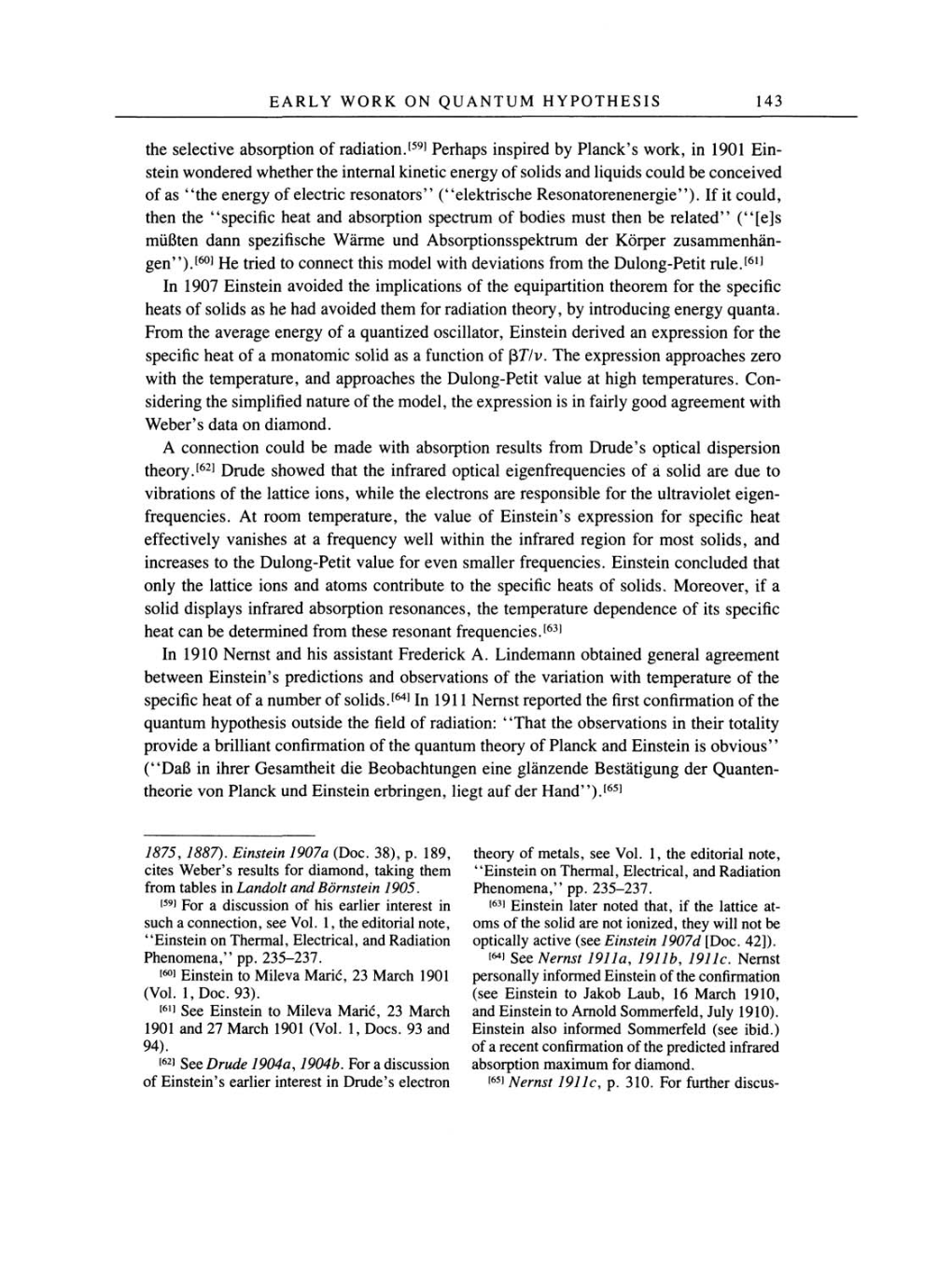EARLY
WORK ON
QUANTUM
HYPOTHESIS 143
the selective
absorption
of
radiation.[59]
Perhaps inspired by
Planck's
work,
in
1901
Ein-
stein wondered whether
the internal kinetic
energy
of
solids and
liquids
could be
conceived
of
as
"the
energy
of
electric
resonators"
("elektrische
Resonatorenenergie").
If
it
could,
then the
"specific
heat and
absorption spectrum
of
bodies
must
then be
related"
("[e]s
müßten dann
spezifische
Wärme und
Absorptionsspektrum
der
Körper
zusammenhän-
gen").[60]
He tried to
connect
this model with deviations from the
Dulong-Petit
rule.[61]
In 1907 Einstein avoided the
implications
of
the
equipartition
theorem for the
specific
heats
of
solids
as
he had avoided them for radiation
theory, by introducing energy quanta.
From the
average energy
of
a quantized
oscillator,
Einstein derived
an expression
for
the
specific
heat
of
a
monatomic solid
as a
function
of
ßt/v. The
expression approaches zero
with the
temperature,
and
approaches
the
Dulong-Petit
value at
high
temperatures.
Con-
sidering
the
simplified
nature
of
the
model,
the
expression
is in
fairly good agreement
with
Weber's
data
on
diamond.
A connection could be made with
absorption
results from
Drude's
optical dispersion
theory.[62]
Drude showed that the infrared
optical eigenfrequencies
of
a
solid
are
due to
vibrations
of
the lattice
ions,
while the
electrons
are responsible
for the ultraviolet
eigen-
frequencies.
At
room
temperature,
the
value
of Einstein's
expression
for
specific
heat
effectively
vanishes
at
a
frequency
well within the infrared
region
for most
solids,
and
increases to the
Dulong-Petit
value for
even
smaller
frequencies.
Einstein concluded that
only
the lattice ions and atoms contribute to the
specific
heats
of
solids. Moreover,
if
a
solid
displays
infrared
absorption
resonances,
the
temperature dependence
of
its
specific
heat
can
be determined from these resonant
frequencies.[63]
In 1910 Nernst and his assistant Frederick A. Lindemann obtained
general agreement
between
Einstein's
predictions
and observations
of
the variation with
temperature
of
the
specific
heat
of
a
number
of
solids.[64]
In
1911
Nernst
reported
the first confirmation
of
the
quantum hypothesis
outside the field
of
radiation:
"That
the observations in
their
totality
provide a
brilliant confirmation
of
the
quantum
theory
of
Planck and Einstein
is
obvious"
("Daß
in ihrer Gesamtheit die
Beobachtungen
eine
glänzende Bestätigung
der
Quanten-
theorie
von
Planck und Einstein
erbringen, liegt
auf
der
Hand").[65]
1875, 1887).
Einstein
1907a
(Doc. 38),
p.
189,
cites
Weber's
results
for
diamond,
taking
them
from tables in
Landolt and
Börnstein 1905.
[59]
For
a
discussion
of
his earlier interest in
such
a
connection,
see
Vol.
1,
the editorial
note,
"Einstein
on Thermal, Electrical,
and Radiation
Phenomena,"
pp.
235-237.
[60]
Einstein to Mileva
Maric,
23 March
1901
(Vol.
1,
Doc.
93).
[61]
See Einstein to Mileva
Maric, 23
March
1901
and 27 March
1901 (Vol.
1,
Docs. 93 and
94).
[62]
See
Drude
1904a, 1904b. For
a
discussion
of Einstein's earlier
interest in
Drude's
electron
theory
of
metals,
see
Vol.
1,
the
editorial
note,
"Einstein
on Thermal, Electrical,
and Radiation
Phenomena,"
pp.
235-237.
[63]
Einstein later noted
that,
if
the lattice
at-
oms
of
the solid
are
not ionized,
they
will
not
be
optically
active
(see
Einstein 1907d
[Doc. 42]).
[64]
See
Nernst
1911a, 1911b,
1911c. Nernst
personally
informed Einstein
of
the confirmation
(see
Einstein to Jakob
Laub, 16
March
1910,
and Einstein to Arnold
Sommerfeld,
July
1910).
Einstein also informed Sommerfeld
(see
ibid.)
of
a
recent confirmation
of
the
predicted
infrared
absorption
maximum for diamond.
[65]
Nernst
1911c,
p.
310. For further
discus–
